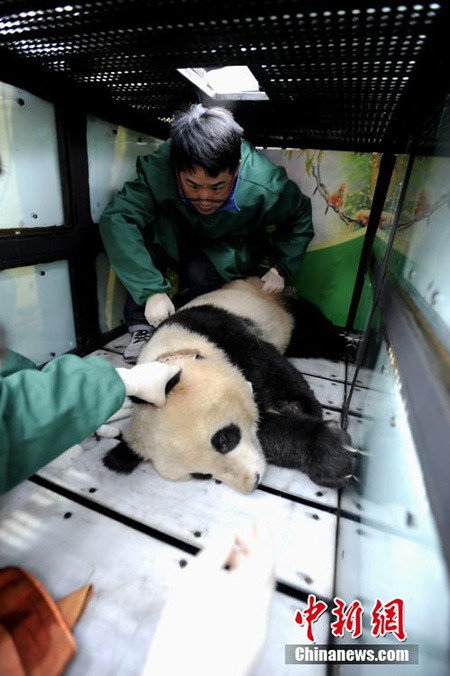
Since, I shared some of our cups Cokie thought it only fair I share her favorite cup too.


Maybe it is a Chinese thing...

Giant panda Hua Jiao is in good shape
and ready to be released into the wild after a physical check up on
Wednesday, according to a local breeding center.
Huang Yan, deputy chief of the China
Conservation and Research Center for the Giant Panda (CCRCGP) said the
animal is in good health, with no signs of any infectious disease.
On Tuesday morning at the wilderness
training reserve on Tiantai Mountain where she has lived for nearly
eight months, center staff lured the two-year-old female into a cage
with bamboo shoots. She was taken to the CCRCGP research base of at
Wolong, the well-known "giant panda's hometown," for a final evaluation.
The base's vets completed a thorough
physical check up on Wednesday. "Hua Jiao weighs 46 kilograms. All the
indexes show she is a well-grown, energetic young lady, ready for a new
chapter of her life,"said Huang.
"She was weaned earlier than her peers,
and so she had to live on her own earlier. She has survived alone in the
wild for about eight months and mastered a lot of skills like finding
shelter and water, and avoiding enemies, so we believe she has a good
ability to adapt to her new environment, and new neighbors in
particular," said Huang.
An ID chip was implanted under her skin
and a GPS collar was put around Hua Jiao's neck while she was
anesthetized for the examination.
A team of researchers then will keep a
watchful eye on her with the help of radio positioning tools and
infrared cameras from the day she is released.
"We will try to leave her alone as much
as possible, as it's the point of the whole program, but if her life is
threatened, like she is critically ill or hurt, we'll lend a hand," said
Huang.
Hua Jiao is the fifth captive-bred giant
panda to be sent back home after a two-year wilderness training
program. She will be released at Liziping Nature Reserve in Sichuan
Province. Her elder brother Tao Tao was released in the same reserve in
2012.
Scientists hope to diversify the gene
pool of the local wild panda community. China began releasing
captive-bred pandas into the wild in 2006 when Xiang Xiang, a 5-year-old
male, was released in Wolong National Nature Reserve. He died roughly a
year later, after fighting with other pandas over food and territory.
In 2012, 2013 and 2014, three more, Tao
Tao (male), Zhang Xiang (female) and Xue Xue (female) were released in
the Liziping reserve. Xue Xue died in November 2014.
"We have taken lessons from Xue Xue's
case. Her parents are both bred in captivity and lacked experience of
surviving in wild. Xue Xue had few wilderness skills. So, this time, we
chose Hua Jiao, whose parents were both born and are living in the wild.
We believe she will do better," said Huang.
Researchers have been following Tao Tao
and Zhang Xiang with the help of GPS collars, radio positioning tools
and DNA extracted from their spoor. Monitoring data shows the animals
are doing well.
Giant pandas are one of the world's most
endangered species. Fewer than 2,000 pandas live in the wild, mostly in
the provinces of Sichuan and Shaanxi. There were 375 giant pandas in
captivity at the end of 2013, about 200 of them at the CCRCGP.
